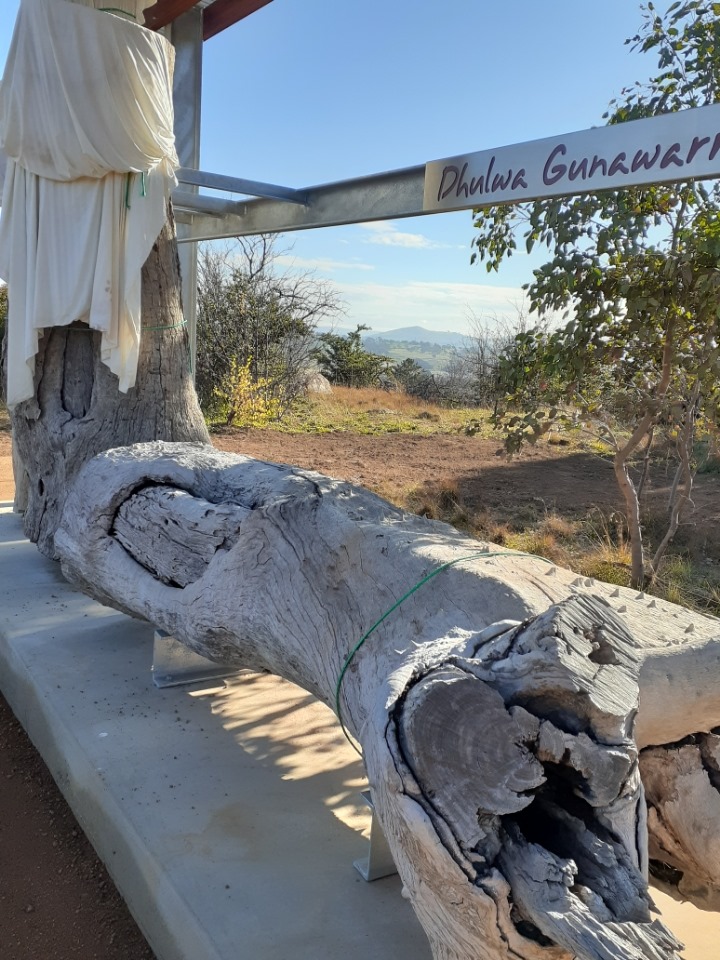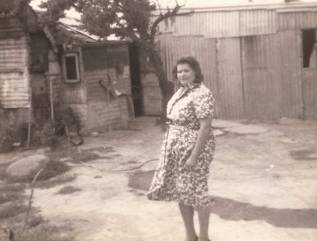
The scarred tree interpretive display at Oak Hill in Yass. Photo: Yass Valley Council.
Note: this story includes an image of a deceased Indigenous person.
Wendy Brown could feel the warm earth beneath her feet as she walked to Oak Hill Aboriginal Reserve in Yass, in the 1960s, to play with her nieces and nephews.
Her sister, Dixie Byrne (nee Brown), was the last to live at the reserve with her family in their grandparents’ old tin house, until 6 November, 1970. Wendy, the youngest of the siblings, lived in the mission at Yass River.
“It was beautiful; we loved it at Oak Hill,” recalled Wendy. “It had a different atmosphere back then. It was more natural. We were connected to the earth and we liked it the way it was.”

Dixie Byrne (nee Brown) outside her house at Oak Hill in Yass. Photo: Supplied by Dixie’s children.
Oak Hill, on the corner of Orion Street and Cooks Hill Road, was where many members of Yass Valley’s Aboriginal community once lived. They shaped the landscape and the landscape shaped them.
Scarred trees grew at Oak Hill for more than 100 years until they were illegally cut down by a developer in 2004. The developer ran out of money and left the country, narrowly escaping penalty.
Wendy remembers discovering one of the scarred trees with Dixie in the 1990s. They were made by Aboriginal people removing the bark for shelters, canoes or vessels such as coolamons.

The scarred trees are partially covered with drapes until the official opening of the interpretive display in spring. Photo: Yass Valley Council.
About three years ago, in the name of reconciliation, Yass Valley Council began working with its Aboriginal Consultative Committee to restore the scarred trees in an interpretative display at Oak Hill. The project was completed at the end of June 2020.
Traditional landowner Lillian Bell’s family also grew up at Oak Hill. She said she is happy to see the three trees back where they belong.
To mark the progress, a Ngunnawal Aboriginal language group has renamed Oak Hill as Yumalundi Dhulwa Gunawari, meaning “welcome Oak Hill”.
A younger generation Ngunnawal person, Tyahn Bell, said the installation would educate the Indigenous and non-Indigenous community about the significance of Oak Hill and scarred trees.
“We’ve always said there is a spiritual connection there, but now non-Aboriginal people in the community can see that physically,” she said.
“Most people don’t know what a scarred tree looks like so even when they’re not at Oak Hill and they’re on other country, they’ll be able to identify them and respect them more.”
The protection and conservation of the trees was an important step in council’s Reconciliation Action Plan. Yass Valley Mayor Rowena Abbey said she hoped the community would visit the installation.
“A scarred tree is a signpost and a story of process,” she said. “I think it will be a good educational resource for people to understand what scarred trees are.”
Schools in Yass, such as Mount Carmel, are already eager to visit the installation to learn about local Aboriginal culture and heritage.
“Context is vital for learning, likewise the opportunity to make connections with real-life experiences,” said Mount Carmel principal Michael Green. “Access to local stories and authentic, tangible resources has an impact on learning that is so much more powerful than textbooks, photographs or YouTube clips could ever provide.”
An official opening of the scarred tree installation will be held sometime between 8-16 November, during NAIDOC Week, which was postponed in Yass this month due to COVID-19.

A path is laid at Oak Hill in Yass. Photo: Yass Valley Council.
Ngunnawal person Brad Bell said he is happy the scarred trees will be preserved for future generations.
“I’m glad we’ll have a place we can go to and reconnect with our country, culture and heritage,” he said. “I think it’s a good example of how mainstream Australians and Ngunnawal people have been working together in the name of reconciliation to see such a significant project completed. I’m proud of it being a part of the story of Oak Hill.”
Ngunnawal person Karen Denny wished to acknowledge Yass Valley’s Aboriginal Consultative Committee and the wider Ngunnawal community for allowing the project to happen, in addition to the help of others.
“I would like to publicly thank the NSW Office of Environment and Heritage, South East Local Land Services, Transgrid and Yass Valley Council for their funding and hard work to get the project finished,” she said. “Now the scarred trees can be an educational showpiece of Ngunnawal culture.”
Original Article published by Kim Treasure on The RiotACT.







